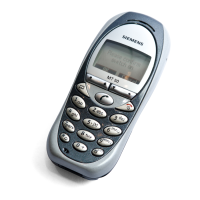V1.0 Page 11 of 46 ICM MP CCQ ST
C45, M50 AND MT50 Company Confidential © Copyright Siemens AG 05/02
4.2.2 Synthesizer: LO1
The first local oscillator is needed to generate frequencies which enable the
transceiver IC to mix an “IF” and to perform the channel selection in the TX part.
To do so, a control voltage for the LO1 is used. Gained by a comparator
(located inside the Transceiver -IC).
This control voltage is a result of the comparison of the divided LO1 and a reference
Signal. The division ratio of the dividers is programmed by the EGOLD+, according
to the network channel requirements.
The first local oscillator (LO1) is part of the PLL which consists of the comparator
inside the Bright (D800), a loop filter and the VCO (Z850) module.
This LO1 circuit generates frequencies from:
3610-3760 MHz for GSM900
3700-3840 MHz for GSM1800
(The VCO can be switched via the signal VSW (Pin 3) to generate frequencies for
GSM900 and GSM1800)
RX IF = no IF required TX IF-GSM900 = 45…46MHz
TX IF-GSM1800 = 90…92MHz
Formula to calculate the frequencies:
1
st
LO freq. RX EGSM = Ch. * 4
PCN = Ch. * 2
The VCO (Z850) is switched on by the EGOLD+ signal PLLON (TDMA-Timer J12)
via V850 and therefore supplied with VCC_SYN. The VCO guarantees by using the
control voltage at pin5 a coverage of the GSM900 and GSM1800 band.
The channel programming of the PLL happens via the EGOLD+ signals SYGCCL,
SYGCDT, SYNSTR (RF Control K14, K15, M15).
The required voltage VCC_SYN is provided by the N840

